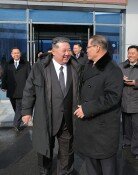Pyongyang’s ballistic missile firing likely to be followed by SLBM launches
Pyongyang’s ballistic missile firing likely to be followed by SLBM launches
Posted September. 26, 2022 07:36,
Updated September. 26, 2022 07:36
North Korea fired a short-range ballistic missile, presumed to resemble the Russian Iskander-M, on Sunday, making it the 5th missile launch since South Korean President Yoon Suk-yeol took office. Around 113 days ago in June, it also fired as many as eight short-range ballistic missiles at one go. The missile from Taechon, North Pyongan Province, conducted a “pull-up" maneuver to fly 600 kilometers at Mach 5 into the East Sea. The South Korean presidential office held an emergency meeting of the National Security Council’s Standing Committee to devise countermeasures.
North Korea’s missile launch on Sunday was conducted one day before South Korea and the United States’ maritime jointly military drills involving the USS Ronald Reagan or a nuclear-powered U.S. aircraft carrier. Not content with causing this large-scale maritime joint exercise by making nuclear and missile threats, the regime then used it as a pretext for an armed protest of defiance. Seemingly, it even intends to justify the 7th nuclear test. Some signs have already been shown that North Korea will carry out additional provocations, such as an SLBM (submarine-launched ballistic missile) launch.
North Korea is accelerating its efforts to advance nuclear weapons by declaring nuclear armament as the regime's core and legislating nuclear strikes. Worryingly, it has intensified the development of tactical nuclear weaponry targeting South Korea. Short-range missiles are also fired to test their capabilities to carry tactical nuclear weapons. However, it only poses a significant threat to Seoul because almost the whole territory is within the range of such missiles.
The National Security Council criticized North Korea for violating the United Nations Security Council’s resolutions and elevating tension on the Korean Peninsula and beyond. It focused on the significance of cooperating with the United States and other allies and friends. This may be the second-best plan because a neutralized UNSC makes it impossible to impose additional sanctions across the international community, including Russia and China. However, there are only so many unilateral sanctions led by the United States or European countries alone can do to keep Pyongyang at bay. That is why a stronger military deterrent is required.
The joint military exercise between Seoul and Washington for three days until Thursday should demonstrate their firm and seamless military readiness against North Korea. As high-ranking officials put it, they should deploy as many capabilities as possible to make an overpowering response to any North Korean provocation. The optimal defense plan that we can put in place is to make it clear to North Korea that it will face the unavoidable consequences of its continued provocations. The South Korean government must also ensure that its National Security Office strengthens its security posture with North Korea in mind. There should be no more vacuum in the leadership of the country’s national security just as seen in the case where not only the national security adviser but also the first deputy director of the National Security Office followed the president on his official trip abroad even while North Korea is highly likely to make provocations.







